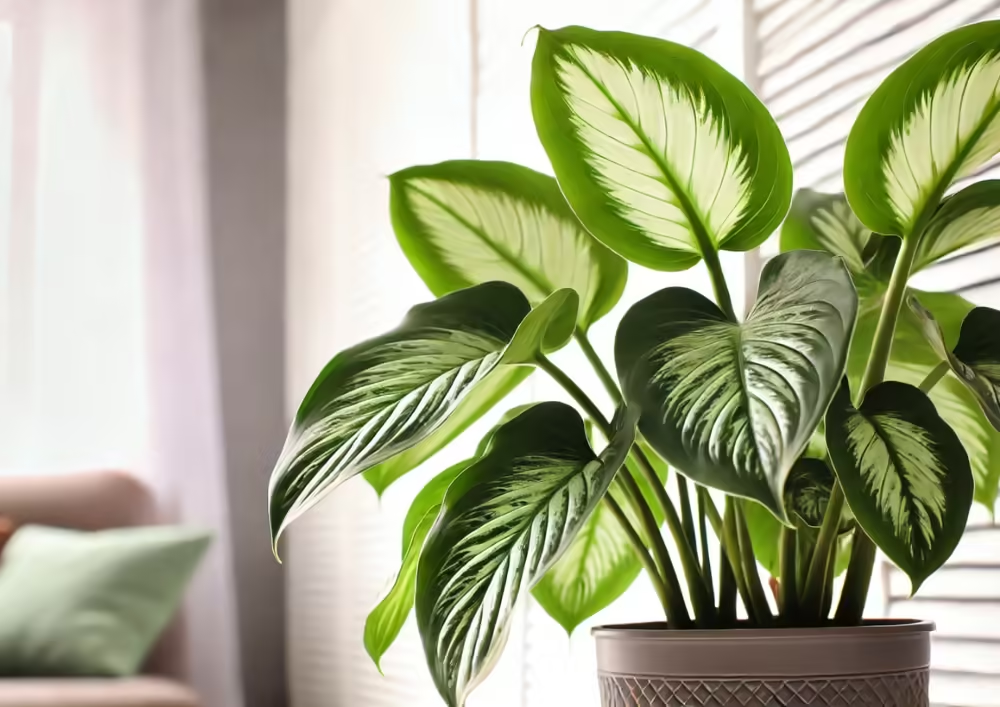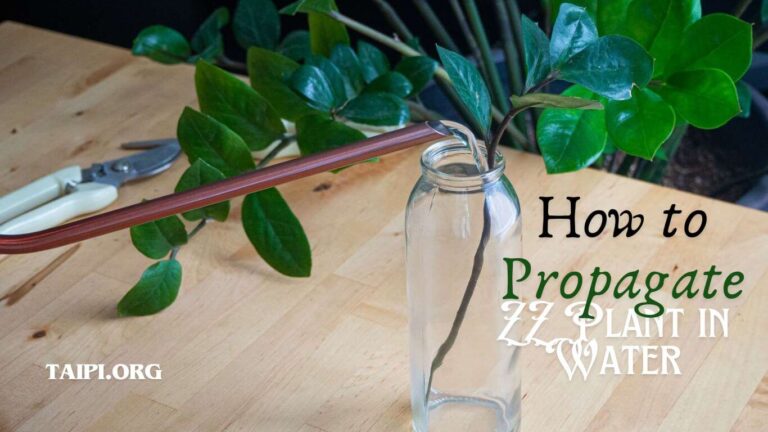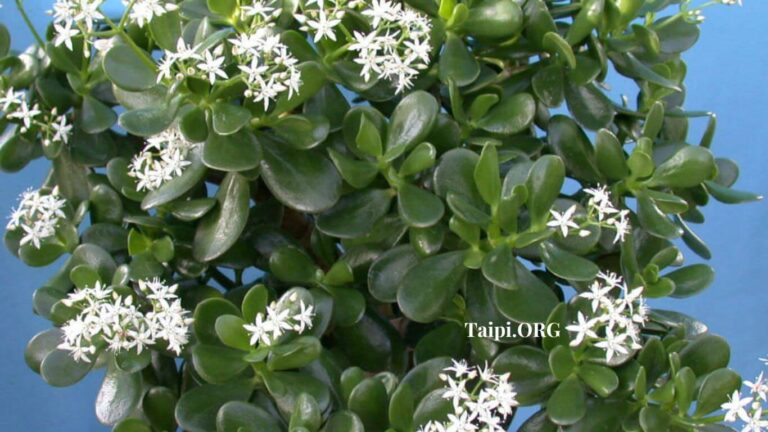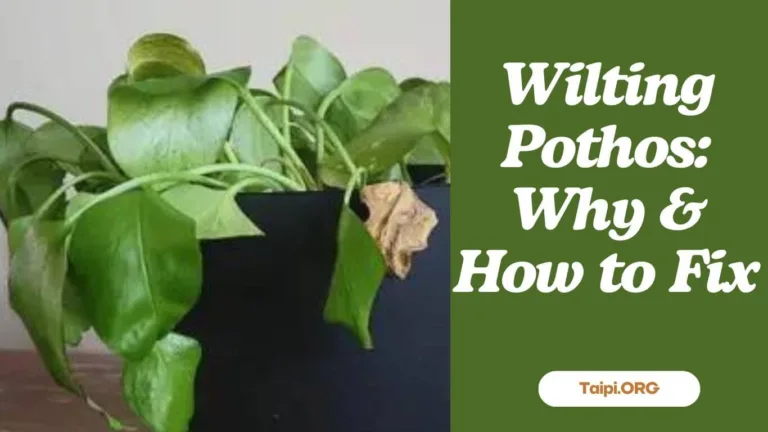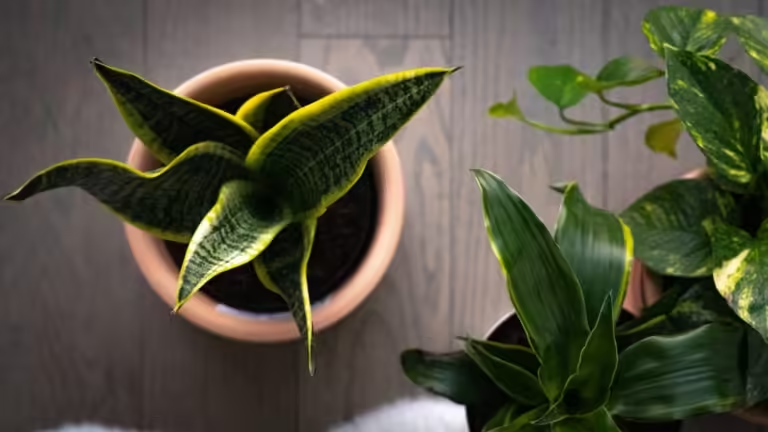How to Care for Calathea Plant Indoors: Comprehensive Guide
I know Calatheas can be finicky and they have a reputation for being divas. So you’ve probably seen them in stores just like I have and walked right on past them and looked at the other plants.
Well, that was always true until it came to this Calathea Orbifolia from the first time I laid eyes on an Orbifolia I knew I wanted one.
It plant is a very tough plant it can survive almost anything. However, if you do a mistake with this plant, it will show you directly. That means that it will not look as good as you want it.
The Calathea is native to the rainforests of Brazil. the common name for this plant is the living plant or the prayer plant.
I love big beautiful broad leaves with silver contrasting bands. But I know that Calatheas can be divas and very hard to care for. But, after several months that I have been with this awesome plant, I find it to be very hardy and easy to care for.
So I want to let you know how I care for my Calathea Orbifolia. So let’s jump right on in and get started.
Calathea Basic care Tips
Some basic things that I do with Calatheas, is gently wiping down the top as well as the bottom of the leaf. This will remove any dust buildup or pests. I just use a soft microfiber cloth. Because it’s not abrasive and you don’t want to do anything that may damage your leaves.
So you don’t want to be too aggressive here. This is a good way to spot any pests that your plant may have in its early stages. If you do this regularly.
Another good thing to do is check periodically to see if there are any dead leaves that you want to remove. Because that’s a breeding ground for things such as fungus gnats and other pests. These two steps can be quite tedious if you have a large plant collection. However, it definitely aids in preventing the early detection of pests which can definitely save your collection.
Special care Tips for Calathea Orbifolia
Let’s get to specific care of the Calathea Orbifolia. As always, I have done quite a bit of research to find out about the care of this plant, and as happens quite a bit. I find that things that I do are quite contrary to what is recommended in a lot of the research that I’ve done. One thing I want to stress is, if you have one of these plants and it is striving & it is doing well, then don’t change it is working in your environment.
That’s one thing you have to learn about your environment and the environment for every home is different. So keep that in mind what works for me may not work for you. On the other hand, if you’re doing everything that’s been recommended by all of your research and your plant is still not doing well you might want to think outside the box and try something different.
Soil
The Calathea Orbifolia has fibrous roots. So your soil mustn’t hold too much water or too little. If it holds too much water your roots will rot. If it holds too little, they are prone to dry out.
For, Calathea I decided to go with a loose soil mix. It’s pretty much the same mix that I use for my Aeroids. Although all of the research that I did said that the soil should remain moist but not wet. I decided to go with an airy Airoid mix where the water could run through freely.
But it wouldn’t retain much water so I use equal parts of perlite, pumice, orchid bark, and soil. This is pretty much the same mixture in the same amounts that I use for my Aeroids.
Calathea Planting & Repotting
When it comes to planting, when you get this plant to your house or apartment, we recommend you wait for a report for at least one year.
Because it has been a lot of things have been happening in the small lifespan of these small plots. It has been moved from the growers to the shop then moved again from the shop to your home. We have to wait for the repotting. So that it can adjust itself to the new environment.
By doing that you’re actually helping it to become stronger and allowing it to start growing in your house.
When should you repot Calathea?
I recommend at least every two years or every three years depending on the size of a pot and depending on how large you want your Calathea to be.
Because, if you put this in a very wide pot, those small rhizomes will start to shoot out and it will get wider and wider. Most of us don’t have a ton of room in our homes. So if you want to keep it a little bit smaller, then we recommend to every time you repot just move up one or two sizes in the pot and then you wait two years and then you move up again.
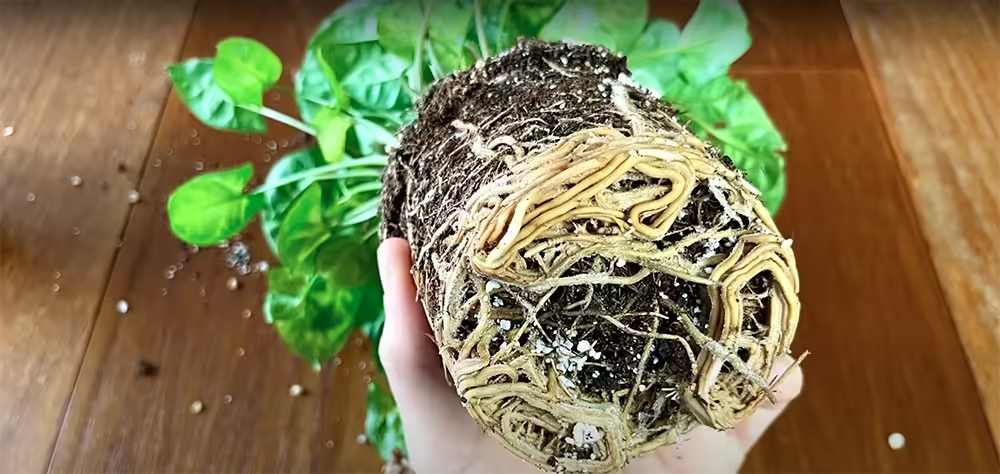
You could put this in a larger pot directly. However in my experience, if you do that what can happen is, all of that soil can absorb a little bit too much water and hold that water for a very long period which could damage the roots.
What kind of soil is to be used for repotting Calathea?
When we repot, we can use any type of normal standard planting soil. But it has a tendency to absorb and hold too much water. So what I recommend you do is to mix up that standard planting soil with perlites. A mixture of eighty percent (80%) of soil and twenty percent (20%) of perlite is perfect for this plant.
Because then you get that good drainage. Because it drinks a lot of water but it does not like to stand in water. So you need good drainage that takes away all of that excess water. It also works fine to plant your Calathea.
Another way to plant this is in a self-watering system. That works perfectly that might even be the best way to plant a Calathea. Because that means that you will have access to water all the time, but not too much water. Because all of the excess water will go down into the water reservoir.
Placements of Calathea
This plant likes to live in an environment where it has at least 22 to 24 degrees Celsius or 72 to 75 degrees Fahrenheit.
If you go below that, you could get problems. If you go above that you could also get problems. So if you are around those temperatures, it will thrive and it will like it.
Where should you put your Calathea in your home?
I found that the perfect spot is to put it in a north-facing window. Because this plant wants to have medium to bright indirect sunlight. As soon as direct sunlight hits the leaves of this plant, you can get problems. So a northern-facing window means that you will get light, but never direct sunlight.
You can also place it in an eastern or western-facing window as well but make sure that the direct sunlight doesn’t hit it too long during the day. If it does, move it into the room a little bit or make sure that it’s standing behind a curtain or something that takes away that direct sunlight.
If you only have a southern-facing window in your home, make sure to move your Calathea into the room so it gets light but no direct sunlight.
If you give this plant indirect sunlight the more, it will grow. So if you want it to stay a little bit smaller, then give move it a little bit deeper into the room. It still needs light, but if you give it a little bit less light, it will not grow as fast.
Humidity
The most important thing concerning Calatheas is humidity. As I said in the beginning, this is native to the rainforest of Brazil where it has a lot of moisture. So you need to have at least 40 percent of humidity in your home for this plant to thrive. But if you know, if it goes below those 40 percent, you will get problems, So you could get problems with this. What happens is that the leaves will start to show directly. You will get brown tips of the leaves you can get brown edges of the entire leaf as well and they can also start to curl.
When they start to curl themselves around the leaves, it is usually a humidity problem. If you see that if you get brown anywhere on the leaves on the edges or the tips or if it starts to curl like that, make sure to raise the humidity in your room.
How to increase/control humidity?
There are many different ways you can do that. The most expensive way is to buy a humidifier that raises the humidity in the entire room. If you don’t cannot afford a humidifier or if you don’t want to spend that money, then what you can do is actually one way to bundle the plants together in wintertime. As a result, they will actually help each other to raise the humidity around themselves.
However, if you get pests or any other problems that can also mean that you get them on all of your plants.
Another way is to put to take a larger saucer just a couple of centimeters high, put some gravel or stones or anything on that saucer, then place your Calathea on the saucer. Then you add water to that saucer. You do not want the Calathea to have access to that water. What you want is for that water around the plant to evaporate and thereby increasing the humidity around your plant. it’s a very simple way that works.
Another thing that can create problems for you are windows in wintertime. If you know that you have windows that get quite cold or have windows that have a draft or if you open the windows during wintertime. Make sure to move your Calatheas to another spot during winter. Because they will get damaged directly, if the temperature goes below or if it gets that cold draught.
What is the best way to water a Calathea plant?
The Calatheas want to have access to water all the time. But it should never stand in water. What I mean by that is that you want to keep the soil just evenly moist at all times, but it should never stand in water.
So one way of doing that is, when you water this if you have drainage holes in the bottom, you can take it to your sink or your bathroom and water it and let the excess water go out of the pot. Then you know that it’s evenly moist and then you can use just use your fingers to feel the soil when the soil is dry around two and a half centimeters or one inch down into the pot, it’s time to water it again.
In the wintertime, if you know that you have a little bit of drier air in your home then you should let it dry out a little bit more. So in the winter time, you could even let it dry out five centimeters down into the soil or two inches instead of one, so let it dry out a little bit more during the winter time because this is a plant that goes a little bit dormant over winter.
What happens if you give too much water?
if you give your Calathea too much water or if it’s standing in water, you can get problems. The first thing you’ll notice, if you give it too much water is, that the leaves will start to become yellow and also some of the stems as well can also start to become yellow.
If you see that that’s an indication of too much water. If it’s standing in water you could get root rot. Also, it will show you that almost immediately by giving you black spots on the leaves. It would just appear to be round black spots on the leaves which is an indication of root rot. If you get root rot then you re-pot your plant and make sure to take away those affected roots.
What happens if you don’t give enough water?
If you give it not enough water what happens? The first thing that can happen is that the plant starts to wilt a little bit & it starts to hang. These plants move their leaves during the day. But if you notice that in the evenings it’s not moving the leaves upward. Sometimes They’re still hanging down. That is an indication that you haven’t given your Calathea enough water.
So start watering it a little bit more frequently, not more water just more frequently to keep it evenly moist. Another thing that can happen quickly is that you will get brown tips of the leaves and or brown edges. This is the reason why this plant is high maintenance. Because if you make a mistake it will show it directly and when it does it usually happens a lot.
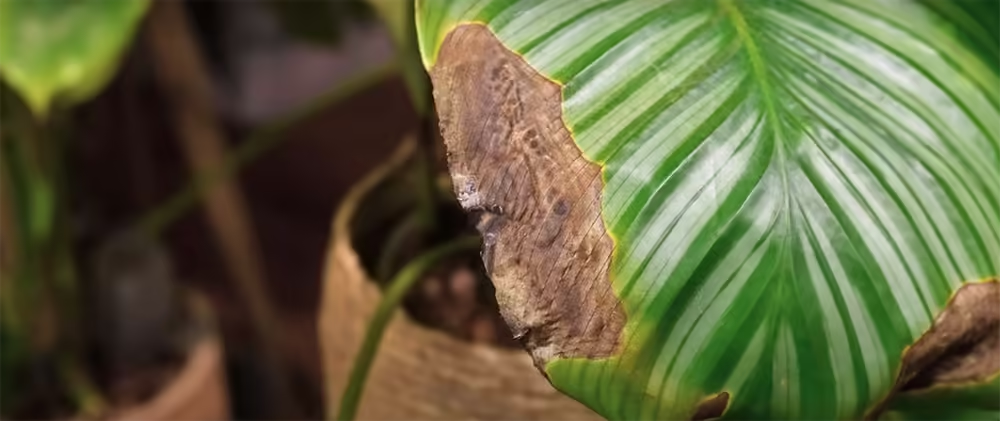
If you give it a little bit too much water a lot of the leaves start to get yellow. If you’re not watering it enough a lot of the leaves will get brown tips and brown edges and it will just look bad. Those brown tips and edges will never go back to being green again.
If you have a Calathea that just looks bad, that’s why it’s high maintenance & you need to make sure that it gets exactly what it wants.
Another thing that can happen to your Calathea, if you’re not watering it enough is that the leaves can start to curl. If you see them starting to curl, it could be a humidity problem but it can also be not enough water. So if you see that on your plants then what I recommend you to do, is just take it to your sink take it to your bathroom & make sure to give it a nice good soak with water.
Then you just let the excess water go out of the pot. If you see that the leaves start to uncurl then you know that you’ve rectified that problem. Make sure to increase the frequency of when you water your Calathea and that problem will just go away.
I recommend you shower your Calatheas with water at least once a month. The reason for that is that we want to get rid of the dust. Because a lot of the dust in the air will settle on the leaves and they will hinder the photosynthesis of this Calathea plant.
Another thing people tend to do is that they mist their plants. They’re not rinsing the leaves off with water they’re misting it with a spray bottle. That is also because they want to raise the humidity around the plant. But, my recommendation is to raise the humidity in the entire room instead.
Pruning
As I said in the beginning this is not a plant that gets to be very tall. It lives on the bottom of the rainforest floor and it gets wide instead. If you think that some of your leaves here actually get to be too wide you can just prune them off. Just cut them off at the base or a little bit higher, it doesn’t matter you can take away that entire leaf that you think is too high.
Otherwise what will happen is that it will start to grow and get become wider. So if you do not want that, you can actually prune the newer leaves that are coming out of the soil making the plant wider. Just cut them off at the base. This will trigger the rhizome underneath to just continue growing but you will slow down that process a little bit. You’re not hurting the plant in any way. You’re just preventing it to grow.
Fertilizing your Calatheas
When it comes to fertilizing your Calatheas or nutrients for your Calatheas. This is a plant that wants quite a lot of fertilization. What I mean by that is that you need to follow the instructions on the fertilizer that you are buying.
I’m not saying that you should add more than that. You need to add the correct amount of fertilization you are buying and using. It needs that. Because if it’s not getting enough nutrients you will see that a lot of the color on the leaves will start to fade. If your plant looks a little bit shaded or faded in color it could be a nutrient deficiency problem.
What we do to rectify this it’s that, make sure that when it is active during its active period, you add fertilizer as it says on the box. If you do that you will never get a problem with nutrient deficiency. But if you get a problem then you can start adding those nutrients and it will rectify that problem.
Depending on which type of fertilizer you use, you will add the nutrients every one or two weeks and that is also depending on which way you water your plant. If you have it in a self-watering system, you’re maybe only watering it once a month then you should add those nutrients or the fertilizer every time.
But if you have it on a windowsill and you’re watering it maybe every other day or every three days or something then once a week or every other week, you should add fertilizer to that water. But as I said, always follow the instructions on the fertilization that You’re using.
Calathea Pest Control – How to Deal With Them?
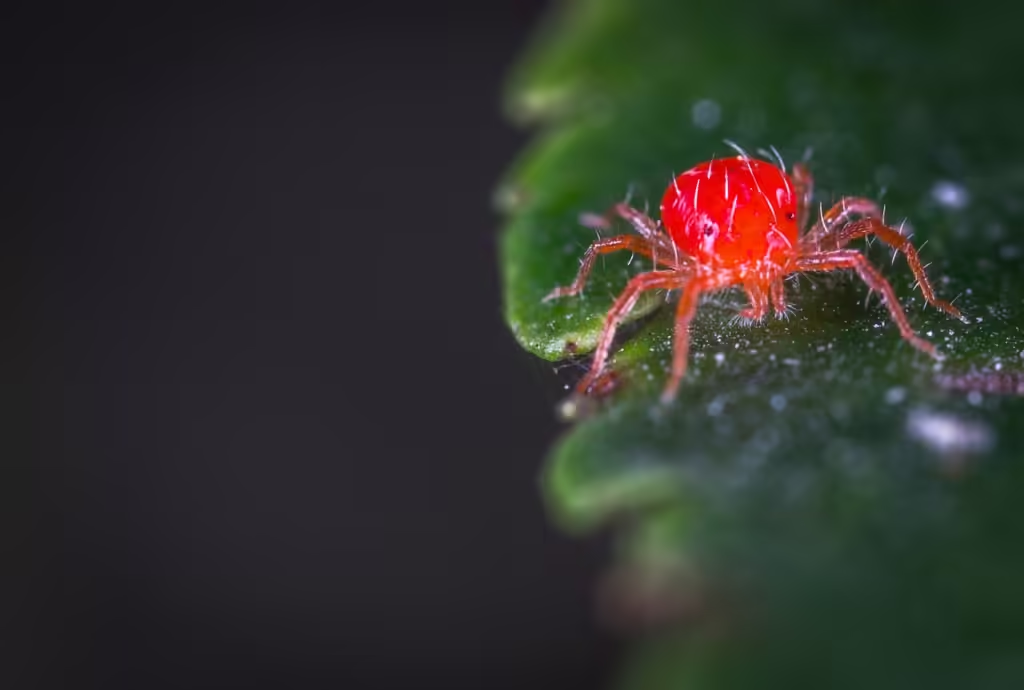
This plant has a tendency to get pests. If it’s not getting exactly what it wants, as soon as it has some form of a problem. It’s sending out a signal to all the pests that come on, I’m not feeling well just hit me and it does. Usually, it’s spider mites that are the most common pest that we have had on the Calatheas that I’ve taken care of over all of these years.
What to do if you get that?
First of all, it is an indication of something is wrong. The possible reasons are as follows.
- You’re either watering it wrong
- Not giving it enough light or giving it too much light
- You’re or you’re not giving it fertilizer or you’re giving it too much fertilizer
- You don’t have enough humidity in your room or you have too much-emitted humidity in your room
So, try and find out what the real problem is as to why you got those pests. Then you can take care of the pests. Luckily spider mites are quite easy to take care of. You could go out and buy a pesticide & just follow the instructions. Usually, you should spray the plants with some form of chemical two or three times around a week.
Then that will get rid of all the pests. But you can also take this plant outside or into your bathroom into your bathtub and you can rinse it off with water. You should do that every day for two weeks. If you do that, you will get rid of the spider mites. It will get rid of all those eggs that will hatch. Because every time you shower it with water, it will just be knocked off the plant and go down the sink.
In two weeks and your problem will probably be gone. This is the most natural and environmentally friendly way of getting rid of those spider mites.
Final Words
A really good thing about Calathea is that they are not poisonous. They’re not poisonous for humans and are not poisonous for pets. So this is a plant that you can have in your house and not worry about it.
Having said that, you should never let your dog or cat or a child or anything bite and eat any of the leaves on this plant. if they do, it’s not that big of an issue.

